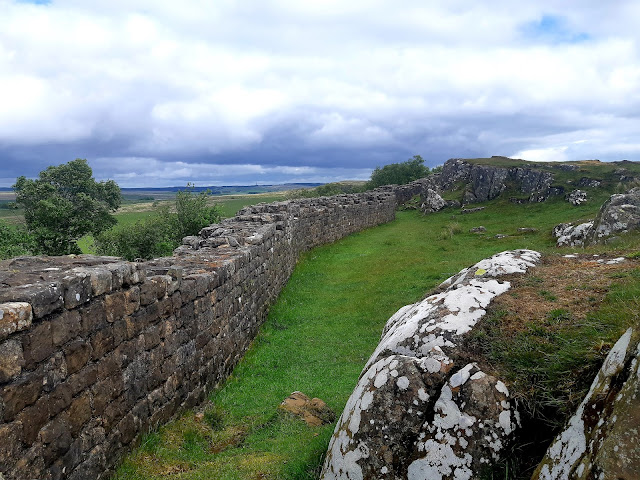Today was our "rest day" taking a very slow start, enjoying a leisurely breakfast before walking out into the rain. Luckily we only had a short walk before reaching the Roman Army Museum where we could hide from the weather for a while. With it's bright displays, "holographic" teacher, and 3D film, this museum feels more aimed at kids, but I did pick up an interesting snippet or two.
Emperor Hadrian wanted to consolidate rather than expand his empire, so ordered the Wall built in AD122, to keep back the barbarians to the North. Although some sections were initially built of turf and wood, the whole thing was eventually made in stone - 12 feet high and 8 feet wide, with "mile forts" every Roman mile (1481m) and two watchtower turrets evenly spaced between each fort. The wall was also protected on it's southern side by a deep ditch, with access over gated paths - this kept the locals safely out of the military zone and reduced the possibility of attack from behind.
Though duty on the wall would generally have been fairly isolated, fortresses like Vindolanda provided a hub for bath houses, taverns, trade, and all other requirements for soldiers on RnR.
The walk itself follows the wall as it rises and falls along the steep crags and "gaps". The crags' sharp northern cliffsides providing added height to an already formidable barrier. Sometimes the wall disappears altogether, stone having been reappropriated for other buildings, such as Thirlwall Castle, in the many years since.
Some of the most complete ruins in this section is the fortress of Aesica, built on the site of Mile Fort 43. Here sections of gatehouse jut from the earth, and some central structures are visible as hummocks in the grass. Of particular interest is a stone altar, an image of a jug carved into one side, standing in the centre of a walled square. I have since found remarks that it was placed there around 1928, evidenced by complaints to an archeological journal at that time about the addition. Of course it may be legitimate Roman remains, moved from a less obvious site, but that seems to be unknown. Regardless it has captured the attention of walkers for almost 100 years now, with gifts (offerings?) of coins adorning its surface.
 |
| Thirlwall Castle (14th C) |
 |
| Turret remnants |
 |
| A natural barrier |
 |
| Aesica West gatehouses |
 |
| Well ensconced now, but not its original position |









No comments:
Post a Comment